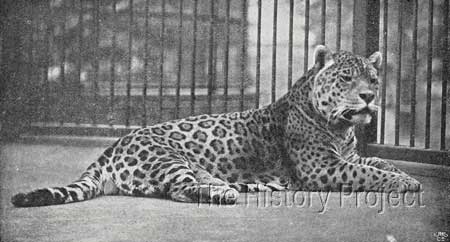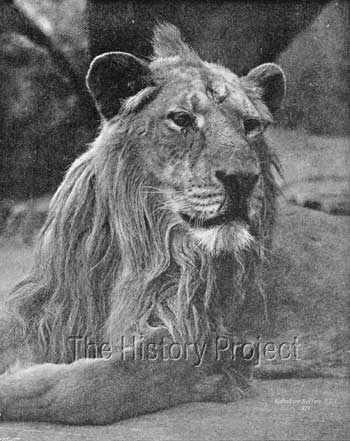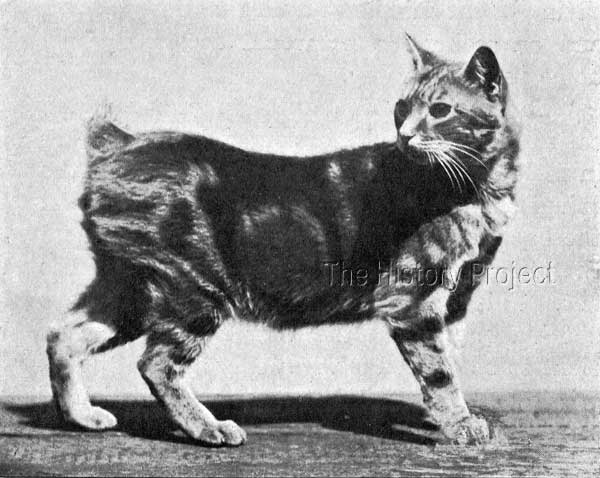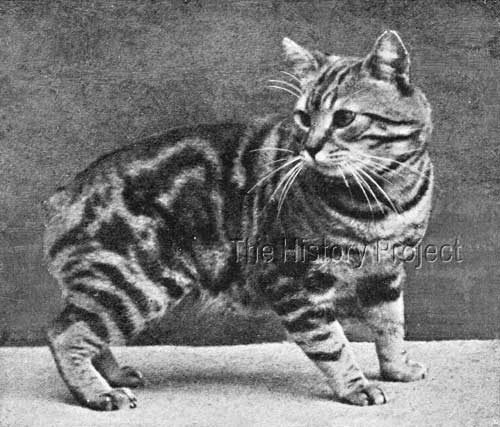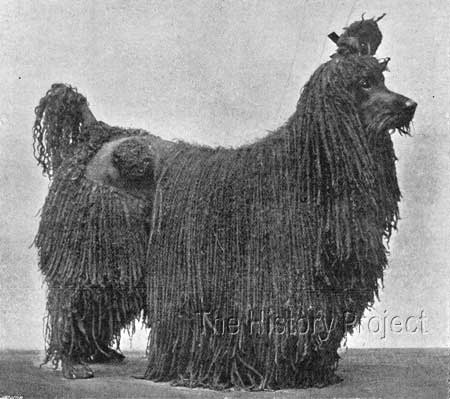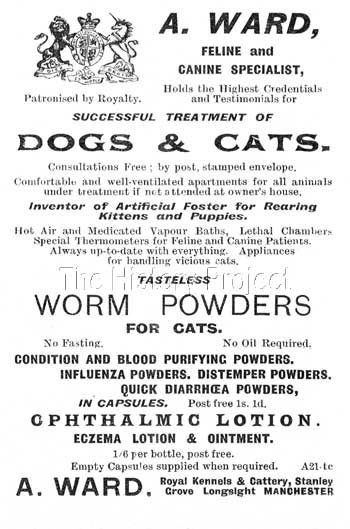 | |||||||||||||||||||||||









|
MANX SILVERWING (c1899)PHOTOS | SOCIAL MEDIA | REFERENCES
HISTORICAL BACKGROUND:Many interesting Victorian ladies and gentlemen were drawn into the world of showing and breeding of domestic cats, among them a number of learned gentlemen, very often from various fields aligned with, or generally complimentary to, the wider interest of naturalists. In the very early days of the Fancy, such notables as Charles Darwin and William Bernhardt Tegetmeier were involved either as sponsors of shows or gave service as early judges. From the world of poultry, pigeons, rabbits, and most notably dogs, came a raft of men, most of them with naturalist leanings in one form or another, including Harrison Weir himself. Weir was considered to be one of the foremost experts on poultry in England, on an equal footing with Tegetmeier, and he was also a highly respected hobby ornithologist. But his popularist claim to fame was as one of most distinguished animal illustrators of the Victorian age. Charles Darwin, who was in regular written contact with Harrison's older brother Jenner Weir, once visited Harrison to personally seek new stock and gain advise from him on the breeding of pigeons. John Jenner Weir, while equally respected for his knowledge in ornithology, was better known as an eminent entomologist. He, along with his brother Harrison, and the Rev. J. Cumming Macdona was one of the first three judges to officiate at a Crystal Palace Cat Show. Other gentlemen who entered the world of 'cats' from or through the world of dogs included Mr. Charles H. Lane, Mr. H.C. Brooke, Messrs E. & S. Woodiwiss, Mr. George Billings, Mr. Fred Gresham, Lord Alexander and Mr. Gambier Bolton, to mention but a few. The latter had, in particular, made a name for himself in the field of wildlife photography, travelling extensively to record some of the most dramatic and respected wildlife photographic art of the era. He was particularly interested in big game cats, and his photographic studies of lions, tigers and other large felines, brought him international notoriety and unprecedented access to the zoos of England, Europe and the Americas. He enjoyed particularly close connections with the Duke and Duchess of Newcastle, the Duchess being among the foremost of gentlewomen involved with the breeding and judging of dogs. She was particularly well known as a 'conformation' judge of high repute. So much so, that when Charles Lane, completed his work on, Dog Shows and Doggy People (1900), he dedicated it to her Grace. "..who by her condescension, personal patronage, and support has raised the tone of dog shows and done much for the benefit of the whole doggy community.."7 The Duke, who similarly shared Bolton's passionate interest in Natural History photography, invited Gambier Bolton to accompany him on his world tour in 1893/94. It was likewise through the doggy world that he also came into contact with Mr. and Mrs. H.C. Brooke, whose interest in 'foreign' and unusual dogs, would have no doubt piqued his interest. In this way he also met with others who had a combined interest in dogs and cats, such as Sam and E. Sydney Woodiwiss, and in no time at all he became a registered breeder and owner of Long-haired cats, then Manx, and was known to be a strong supporter of the Siamese. It is to his interest in Manx cats, that we are now drawn and, in particular, to his stewardship of 'Manx Silverwing'.
PARENTAGE & OWNERSHIP:
Unknown
Unknown
| Unknown
Manx Silverwing, circa 1899, Silver Spotted Tabby Manx, F
| Unknown
Unknown
Unknown
The only registration records for 'Manx Silverwing' are contained in 'The Cat Club Register', which only divulges that her pedigree is 'unknown', that she was owned by Mr. Gambier Bolton, and that she was a "Spotted Silver Manx female". ³ So we have no official record of her breeder or her date of birth. However, we may assume an approximate date of birth from the fact that she was successfully bred by Mr. Bolton, giving birth to recorded progeny in June, 1900, and again in May 1901. In order to have been mature enough to be bred and produce a litter in June of 1900, she must have been born at least as late as the middle of 1899, and her date of birth could have been even earlier. As to her breeder, if we look to convention for a clue, all those Manx cats registered in the National Cat Club Stud-books, Volumes 1-5, which had their names prefaced with the word 'Manx', were bred by Mr. E. Sydney Woodwiss. There are no exceptions. It therefore seems very likely that he was also the breeder of 'Manx Silverwing' and possibly also 'Manx Primrose', a Black Manx female, who is similarly listed in 'The Cat Club Register' as owned by Mr. Gambier Bolton, with no breeder. Interestingly, for 'Primrose' we have a date of birth as 2nd April, 1899, and a listed sire and dam. So it would appear at least based in the realm of possibility, that both cats may have been acquired by Mr. Robert Gambier Bolton at around the same time.
Mr. Bolton was no newcomer to domestic and pedigreed cats, and/or to exhibiting. He owned a number of Longhairs, predominantly silvers and smokes, registered with The National Cat Club. The earliest of these appears to be a Silver Tabby male named 'Punto' (NCC:1056), born in April of 1888, bred by Mrs. Radford of Woodford, Essex. 'Punto' appears to be his earliest stud male of record, and the sire of a smoke long-hair female of his own breeding, named 'Poppy' (NCC:1878) out of his smoke queen 'Flit' (NCC:1877), born 2nd August, 1894.4 Other long-hairs included 'Izeyl', (NCC:1703), a silver tabby female bred by Mrs. Taylor, born on 1st March 1893; 'Psyche' (NCC:1767) (aka Garboldisham Psyche), a Blue Tabby female bred by Mrs. C.L. Kennaway, born 25th March, 1894; 'Meme II' (NCC:1876), a Silver Tabby female, born January 1893, formerly owned by Mr. Crang, sired by Beau (himself by Miss Simpson's 'Beauty Boy') and out of 'Meme' a cat imported from Paris. He was also the owner of the Smoke longhair male 'Pompey' (NCC:1875),born 27th March,1894, sired by Mrs. Herring's 'Blue Jack'. 'Pompey' was bred by Miss Rogers, and took a first at the Crystal Palace in 1894.4 From the above we can certainly see a leaning to the silver tabbies, so it should come as no surprise that when his interest turned to Manx in the latter part of the 1890's, that 'Manx Silverwing' would instantly appeal to him. On his extensive travels in the east, he learned a great deal about unusual cats and took a scientific interest in all the Asiatic breeds of domestic cat. By the time Frances Simpson penned her classic work 'The Book of The Cat', in 1903, Mr. Bolton was a well-known and respected member of the feline fraternity, with more than 10 to 12 years of involvement in the fancy. Miss Simpson had no hesitation in seeking out his expertise and support in the chapter on Manx cats, to which he was a contributor. Dispelling all the myths associated with the establishment of the Manx breed on the Isle of Man, Miss Simpson firmly espoused her belief that these tailless cats had mostly likely descended from a foreign breed of cat brought to the island. In support of this assumption, she quotes from Gambier Bolton, whose opinion was duly published: "Any traveller in the far east - Japan, China, Siam, and the Malay region - who is a lover of animals must have noticed how rarely one meets with a really long-tailed cat in these regions, for instead one meets with the kink-tailed (i.e. those with a bend or screw at the tip of the tail), the short-kinked tail (i.e. those with a screw-tail like the bull dogs), the forked-tailed (those having tails which start quite straight, but near the tip branch out into two forks), and finally the tailless (or miscalled Manx) cats; and the naturalist Kaempfer states definitely that the specimens of this breed now so common in parts of Russia all come originally from Japan."
And then, presumably quoting from his own experience in breeding Manx cats, he continues: "Again, anyone who breeds these tailless cats, and keeps the breed quite pure, must have noticed how they differ in appearance and habits from the common short-haired cats. They are, and should be, much smaller in size; the coat should be longer and more 'rabbity'; the 'call' is much nearer that of the jungle cat of the East than that of the ordinary cat; and their habits, are much more dog-like. In all these points they keep closely to what the writer firmly believes to be their original type, the domesticated cats of the Far East." He then describes and espouses those qualities in a fine show specimen that he finds so endearing: "The photographs illustrating this article give some idea of the general appearance of these delightfully quaint little creatures, and one notices immediately the great point which all judges look for, viz., the high hindquarters, which is so typical of the tailless breed of cats, the few hairs, which represent the spot where the tail should be, constantly appearing even a few hours after birth, although there is not a sign of a caudal appendage beneath them. "Kink-tailed, screw-tailed, fork-tailed, and absolutely tailless cats have all been exhibited at British shows of recent years, and the writer, from a personal knowledge of nearly all breeds, has no hesitation in recommending the latter as companions, their quaint and dog-like ways making them general favourites whenever they are met with."2
Mr. Bolton was not, however, the only owner of record for 'Manx Silverwing'. But he is the only owner under whose name her subsequent progeny was registered. Probably due to his many commitments to travel abroad on photographic excursions, he may have found it necessary to rehome some of his cats from time to time. In 'The Book of The Cat', Frances Simpson records her transfer of ownership, firstly to Mr. Foulstone, and then her subsequent sale to Mr. A. Ward, the well-known Canine and Feline Specialist in animal remedies.
In the 21st December 1901 issue of Our Cats the change of ownership to Mr. Ward is recorded in a report on the Northern Counties Cat Club's Manchester Show as follows: "A few cats were sold. Manx Silverwing was claimed by Mr. Ward directly the show opened. There were several claimants for this sweetly and quaintly marked cat." SIBLINGS & SHOWS:There is no clear evidence of any siblings of 'Manx Silverwing', but this does not preclude that she did not have any, only that none have been recorded. It is clear from the commentary of Frances Simpson, who, in 1902 stated "Silverwing has won many prizes, and calls forth great admiration whenever exhibited"1, that in fact 'Silverwing' was shown fairly often as a young cat, drawing much attention and admiration to herself. But official records of any winnings are scant, with the only one First recorded as won at Manchester, in Volume Six of The National Cat Club Register.8 BREEDING & PROGENY:Although owned in turn by Mr. Gambier Bolton, Mr. Foulstone and Mr. Ward, the only progeny of record are those bred from 'Manx Silverwing' while under the stewardship of Mr. Gambier Bolton.
In 1900, she was bred to Mrs. H.C. Brooke's 'Katzenjammer', and from this pairing was produced a Blue Tabby female comically named 'D-TAIL', born 24th June,1900. 'D-Tail' was retained for breeding by Mr. Bolton. Frances Simpson casts some light on the quality of 'D-Tail' and of her eventual mysterious loss. "Mr. Gambier Bolton owned and bred some fine cats. 'Manx Primrose', a black, and 'D-Tail' a silver tabby, won respectively first and second at the Westminster Show in 1902. It is so usual to see 'breeder and pedigree unknown' after almost all the entries in the Manx classes, that these two cats were distinguished by having a certified pedigree. It was a grievous loss when 'D-Tail' disappeared very mysteriously from his home in St. John's Wood. 'Manx Silverwing', passed from Mr. Bolton's possession to that of Mr. Foulstone's, and was later purchased by Mr.A.Ward, the well-known cat specialist." The following year, she was bred to Miss Smart's 'Ibsen', and from this combination she produced another female, a solid black, named 'PING PONG', born 12th May, 1901. PHOTOS:
SOCIAL MEDIA :
In Summary: Gambier Bolton, may have started out as a talented amateur photographer, but in time, he became the world's first widely celebrated animal photographer. As a fellow of both the Zoological Society and the Royal Geographical Society, he was commonly afforded access to many wild animals held in captivity. In 'How to see the Zoo', author C.J. Cornich, commented on seeing the celebrated British photographer of wild animals at the London Zoo, sitting there by the hour, with his camera beside him, ready to photograph each new and characteristic attitude. "To watch Mr. G. Bolton is to learn how to see the zoo from another point of view, than that common to ordinary or even scientific visitors. He is concerned, not with the habits, but with the form, appearance, and attitudes of animals."9 In 1899, W. Watson and Sons constructed a camera based on Mr. Bolton's personal specifications. It was designed to serve as a combination camera, for use in long distance photography, and/or as a readily available hand camera. It will probably come as no surprise that Mr. Robert Gambier Bolton was a committee member of 'The Cat Club', 'The Blue Persian Cat Society' and a foundation committee member of the 'Siamese Cat Club'. His interests were diverse , but he appears to have been ready and willing to lend his support where it would be of the greatest value. It is thanks to his interest in both Silver Tabbies and in the Manx breed, that we can today see, and admire, the natural beauty of his 'Manx Silverwing'. REFERENCES:
Registers associated with this article include The Incorporated Cat Fanciers Association of Great Britain (TICFAGB), National Cat Club (NCC), The Cat Club (CCR), Beresford Cat Club (BCC), Feline Federation Francaise (FFF), Siamese Cat Registry (SCR), US Register & Studbook for Cats (USR)including Supplement(USRS), The Studbook of the American Cat Association (ACA), and the Studbook & Register of the Cat Fanciers' Association (CFA).
|
||||||||||||||||||||||
Home | Cats | Gallery | Clubs | People | Artifacts | Articles | Updates | Contact Us ©The CFA Foundation, Inc and The Harrison Weir Collection
|
|||||||||||||||||||||||

